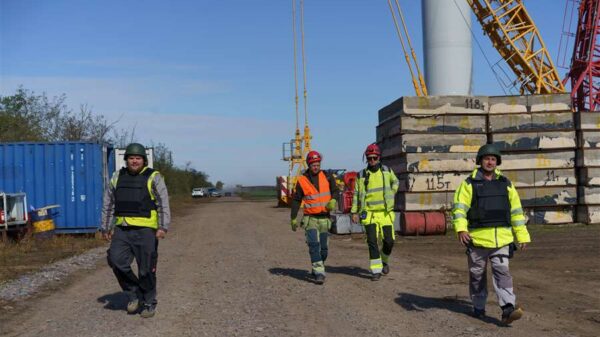Critical Care staff prone a COVID-19 patient on the Christine Brown ward at King’s College Hospital in London, Wednesday, Jan. 27, 2021. The scale of Britain’s coronavirus outbreak can seem overwhelming, with tens of thousands of new infections and more than 1,000 deaths added each day. But on hospitals’ COVID-19 wards, the pandemic feels both epic and intimate, as staff fight the virus one patient at a time, and with no end in sight. (AP Photo/Kirsty Wigglesworth, Pool)
LONDON (AP) — When the U.K. surpassed 100,000 coronavirus dead this week, it was much more than just a number to Justin Fleming.
Lying in a hospital bed with COVID-19, he knew how easily he could have become one of them, were it not for the medics and other staff who worked to save his life.
“I thought I might not see my partner again, my mum — be a dead friend, be just a stat,” said 47-year-old Fleming, who was rushed to King’s College Hospital in mid-January struggling for breath. His condition improved after two weeks of receiving oxygen on an acute care ward.
The scale of Britain’s coronavirus outbreak can seem overwhelming, with tens of thousands of new infections and more than 1,000 deaths added each day. But on hospitals’ COVID-19 wards, the pandemic feels both epic and intimate, as staff fight the virus one patient at a time, and with no end in sight.
Fleming says he was amazed by the diversity of the “incredible” staff — including recently qualified medics, a nurse newly arrived from the Philippines and staff drafted from dental wards and brain injury teams — who eased his isolation and saved him from joining the roster of the dead.
“Because you have to be isolated (with COVID-19), you feel like you’ve just vanished,” he said. “It’s almost like you can become a non-person within a week.”
Fleming is one of more than 37,000 coronavirus patients being treated in Britain’s hospitals, almost double the number of the spring surge. King’s College Hospital, which sits in a diverse, densely populated area of south London, had almost 800 COVID-19 patients earlier this winter. A new national lockdown has seen the number fall to a still-challenging 630.
Critical care consultant Dr. Jenny Townsend works on a 16-bed intensive care ward that currently has 30 patients, with two beds squeezed into each bay designed for one. In normal times, one intensive care nurse looks after one patient. The ratio is now as high as one to four.
“We all feel very stretched and everyone’s mucking in to help each other with each of the roles that is required,” Townsend said.
“We’re doing the best we can, and we’re doing it in very difficult circumstances. We try and deliver as close to what we do normally, but occasionally because of the number of patients, we have to prioritize what we can and can’t do,” she said.
That is especially difficult because coronavirus care is labor-intensive. It takes a village of people and skills to treat each critically ill patient.
One recent day on the ward, Townsend oversaw a tracheostomy, inserting a small tube into a patient’s windpipe to help him breathe without a ventilator — a small step toward possible recovery. Down the hall, family liaison officer Berenice Page held a video call to relatives from a patient’s bedside. More than half a dozen staff worked to “prone” another patient, carefully flipping them onto their stomach to help them breathe more easily.
Like others, this hospital had to adapt fast when COVID-19 first struck in early 2020, finding room for more patients and redeploying medical staff to work in unaccustomed roles. Wards were converted, staff were drafted in from other departments to the new COVID wards and expanded intensive care units.
Then, after a summer respite when cases plummeted, the hospital had to do it all over again when the virus came roaring back in the fall. Many staff find the struggle harder the second time around.
“In the first wave, people’s energy levels were better because we were dealing with the unknown and we learned as we went along,” said Felicia Kwaku, the hospital’s associate director of nursing. “In this second wave it’s worse, because the patients are much sicker, the numbers are higher, the wave feels longer.”
Coronavirus patient Fleming, having seen the pandemic up close, says Britain’s overburdened medics “need credit now — and help and support.”
“This is a significant historical moment and they protected the country,” he said.
While the number of patients being admitted to London hospitals with COVID-19 is gradually diminishing, pressure on medics will only ease slowly because of the time lag between infections, hospitalizations and — for the sickest patients — transfers to intensive care.
That means ongoing challenges for staff like family liaison officer Page. Each day she phones patients’ relatives to update them on their condition, then takes a tablet computer around the ward, so that family members, barred from visiting, can at least see their unconscious loved ones.
“I find it a real privilege to be to be able to talk to them,” said Page, whose usual job is as a resuscitation coordinator.
“You get a glimpse of the patient’s life when you’re doing the video calls, and you see (the relatives) sitting in their homes and some of them have got young children. And, yes, I do feel their despair. But I also I also know what a difference it makes,” she said.
“We’re often talking to people whose relatives are going to die. It’s a very difficult situation. … I think that when they speak to us. I can say that they find some there’s some peace for them,” she added.
Kwaku said the pace of patients being admitted remains “relentless,” and implored lockdown-weary Britons to keep following social distancing rules.
She said hospital workers take heart from the U.K.’s rapid rollout of coronavirus vaccines. More than 7 million people have received the first of two doses.
Kwaku says staff also get a boost from the patients who recover and go home, and take some comfort from those they offer “a good death,” free from struggle and fear.
“You take every shift as it comes, you take every day as it comes,” she said. “You may fall down, and you get yourself up. You may feel low, you pick yourself up. You may have a cry. … But we’re here to care for patients and care for each other.”
Copyright 2020 Associated Press. All rights reserved.






























You must be logged in to post a comment Login